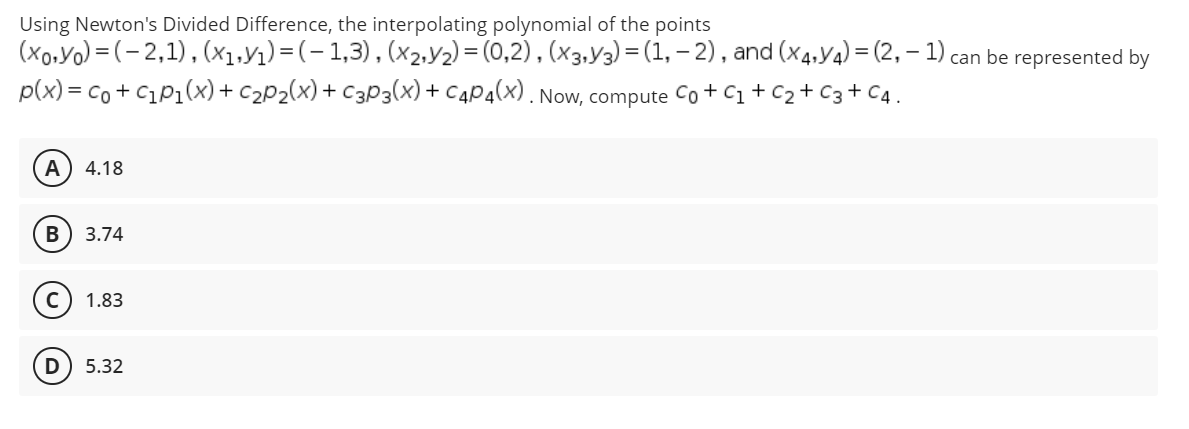Using Newton's Divided Difference, the interpolating polynomial of the points (xo.Yo) = (- 2,1), (x1,y1) =(-1,3),(x2,Y2) = (0,2), (x3.Y3) = (1, – 2) , and (x4,Y4) = (2, – 1) can be represented by p(x) = co + C1P1(x) + c2P2(x) + C3p3(x)+ C4P4(x). Now, compute Co+ C1+C2+ C3+ C4. A 4.18 В 3.74 1.83 5.32
Using Newton's Divided Difference, the interpolating polynomial of the points (xo.Yo) = (- 2,1), (x1,y1) =(-1,3),(x2,Y2) = (0,2), (x3.Y3) = (1, – 2) , and (x4,Y4) = (2, – 1) can be represented by p(x) = co + C1P1(x) + c2P2(x) + C3p3(x)+ C4P4(x). Now, compute Co+ C1+C2+ C3+ C4. A 4.18 В 3.74 1.83 5.32
Trigonometry (MindTap Course List)
10th Edition
ISBN:9781337278461
Author:Ron Larson
Publisher:Ron Larson
Chapter4: Complex Numbers
Section4.2: Complex Solutions Of Equations
Problem 6ECP: Find a fourth-degree polynomial function f with real coefficients that has 2, 2, and 7i as zeros.
Related questions
Question

Transcribed Image Text:Using Newton's Divided Difference, the interpolating polynomial of the points
(xo.Yo) = (- 2,1), (x1,y1) =(-1,3),(x2,Y2) = (0,2), (x3.Y3) = (1, – 2) , and (x4,Y4) = (2, – 1) can be represented by
p(x) = co + C1P1(x) + c2P2(x) + C3p3(x)+ C4P4(x). Now, compute Co+ C1+C2+ C3+ C4.
A
4.18
В
3.74
1.83
5.32
Expert Solution
This question has been solved!
Explore an expertly crafted, step-by-step solution for a thorough understanding of key concepts.
Step by step
Solved in 2 steps with 3 images

Recommended textbooks for you

Trigonometry (MindTap Course List)
Trigonometry
ISBN:
9781337278461
Author:
Ron Larson
Publisher:
Cengage Learning

Algebra & Trigonometry with Analytic Geometry
Algebra
ISBN:
9781133382119
Author:
Swokowski
Publisher:
Cengage

Trigonometry (MindTap Course List)
Trigonometry
ISBN:
9781337278461
Author:
Ron Larson
Publisher:
Cengage Learning

Algebra & Trigonometry with Analytic Geometry
Algebra
ISBN:
9781133382119
Author:
Swokowski
Publisher:
Cengage